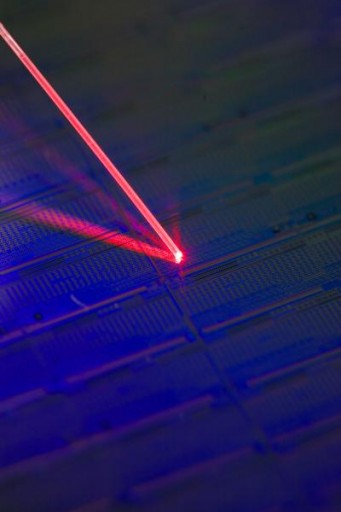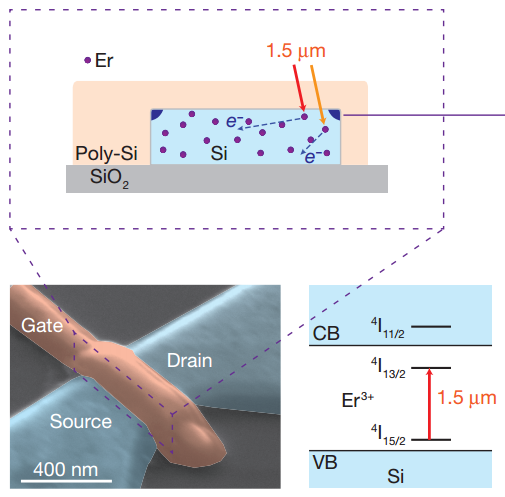Towards a quantum internet
May 3, 2013

A laser light addresses a single erbium atom in a silicon chip (credit: University of New South Wales)
An Australian team led by researchers at the University of New South Wales is the first in the world to detect the spin, or quantum state, of a single atom using a combined optical and electrical approach.
This is a breakthrough in quantum science that brings the prospect of a network of ultra-powerful quantum computers — connected via a quantum internet — closer to reality, the researchers say.
The study is a collaboration between researchers from the ARC Centre of Excellence for Quantum Computation and Communication Technology based at UNSW, the Australian National University and the University of Melbourne.
UNSW Professor Sven Rogge said the technical feat was achieved with a single atom of erbium — a rare earth element commonly used in communications — embedded in silicon.
“We have the best of both worlds with our combination of an electrical and optical system. This is a revolutionary new technique, and people had doubts it was possible. It is the first step towards a global quantum internet,” said Rogge.
How quantum computers work
Quantum computers promise to deliver an exponential increase in processing power over conventional computers by using a single electron or nucleus of an atom as the basic processing unit—- a quantum bit, or qubit.
By performing multiple calculations simultaneously, quantum computers are expected to have applications in economic modelling, fast database searches, modelling of quantum materials and biological molecules and drugs, and encryption and decryption of information.
In a qubit, information is stored in the spin, or magnetic orientation, of the electron or nucleus. Due to a quantum property known as superposition, spin can be up or down, or in both states at once. To produce a functioning qubit, scientists must be able to control, or change, the spin state and then detect, or “read” it.
Researchers previously used either an electrical or an optical method to read the spin of a single atom, but not both methods together.

Photoionization spectroscopy of an individual erbium ion. Bottom: Colored scanning electron micrograph of a typical a single-electron-transistor device used in this study and a band structure of erbium ions in silicon. (CB: conduction band; VB: valence band.) Top: schematic cross-section of the single-electron transistor, showing the optical addressing of individual erbium ions. (Credit: Chunming Yin et al./Nature)
Combining light and electrons
To make the new quantum device, Associate Professor Jeffrey McCallum at the University of Melbourne used an ion implanter to shoot erbium atoms into a standard industrial silicon transistor.
When the atom was in a particular quantum state and laser light was shone on it, an electron was knocked off the atom. This was detected electrically, by the silicon transistor switching on.
UNSW’s Dr Chunming Yin, lead author of the study, said the new approach opens up the possibility of using light to couple the atoms, or qubits, together to form a quantum computer.
“The high spectral resolution of the optical frequency addressing step overcomes the thermal broadening limitation of the previous electrical read-out scheme, and the charge-sensing step avoids the difficulties of efficient photon collection,” the researchers said in Nature.
“This approach could lead to new architectures for quantum information processing devices and could drastically increase the range of defect centers that
can be exploited. Furthermore, the efficient electrical detection of the
optical excitation of single sites in silicon represents a significant step
towards developing interconnects between optical-based quantum
computing and silicon technologies.”
“Using light to transfer information in the quantum state is easier than doing it electrically. Ultimately this will lead to quantum communications over long distances,” Yin said.
Associate Professor Matthew Sellars of the Australian National University said it was a step towards connecting a solid-state quantum computer to what will be the quantum internet.
“The quantum internet will allow separate quantum computers to be integrated and it will enable encrypted communications.”
Professor Rogge said the breakthrough was made possible by combining the expertise of the three groups. The next step would be to control the spin of the erbium atom, which should be relatively straightforward, and also to replicate their results using a phosphorus atom embedded in silicon.
Quantum communication systems will become critical for providing secure communications for government, military, defense, finance business and health industries, but it will be at least another decade before the potential of quantum computation is fully realized, the researchers said.
“We cannot give you a firm date since it is too early,” Rogge told KurzweilAI. “What we have is an enabling technology but not yet a working communication channel.”